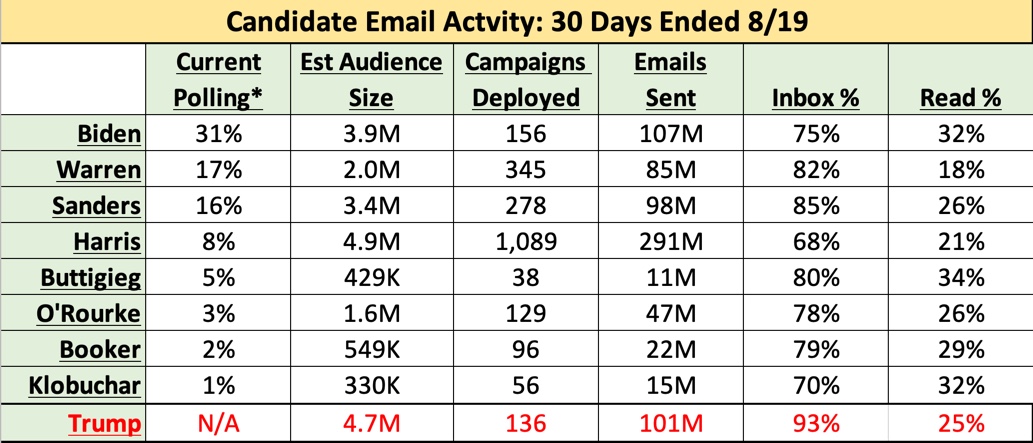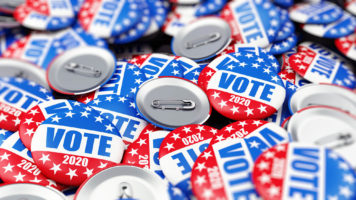Decision 2020: Email from the Presidential Contenders
The next Presidential election is still about fifteen months away, and many of us feel like it’s been going on since the last one ended. The overall impression is like seeing Christmas goods on display in stores before Labor Day.
But here we are, with over twenty declared candidates in the Democratic race, most of them plodding doggedly around key primary states like Iowa, New Hampshire and South Carolina, and also filling email inboxes with their campaign messaging. It’s time to look at some of their programs.
The table below shows recent thirty-day email activity and performance data for eight of the most visible (and viable) Democratic campaigns, and — because he never stopped emailing once he got elected — that of Mr. Trump. The Democratic candidates are listed in order of their current polling numbers, which may have changed somewhat by the time you read this piece.
For the most part, the largest email audiences are owned by the strongest polling candidates. Buttigieg’s is a surprising exception, considering the relatively high profile of his candidacy. Harris and Biden own the largest audiences; Klobuchar and Booker the smallest, along with Buttigieg.
Harris deployed by far the largest number of campaigns, and sent the largest number of emails. Klobuchar and Buttigieg are on the low end of the range for both metrics. Inbox performance is — typically for political email — low for these candidates: none of them is seeing better than 82% deliverability, and Harris’ is only 68%. That translates, respectively, into risky spam rates of 18% and 32%. Politicians are not bound by the strictures of CAN-SPAM regulations, and most tend to have sloppy list acquisition and send practices.
Read rates, however, are generally strong: Biden’s, Buttigieg’s, and Klobuchar’s all exceed 30%. Warren’s are the only campaigns in this group driving read rates of less than 20%. By comparison, Trump owns one of the largest email audiences, and deployed almost as many campaigns and emails as Biden. His 93% inbox performance is strong, as are his 25% read rates. Trump also drove some of the strongest read rates in the 2016 campaign, but was also its biggest spammer. His campaign seems to have cleaned up its email act for 2020, and whoever ends up running against Trump will need to take note of that.

(*) Source: Real Clear Politics Survey Composite as of 8/19/2019)
The table below shows the strongest overlaps between the email audiences of the various candidates, revealing the degree to which individual candidates are truly competing in the eyes of voters who may favor them. So, for example, Biden has only one strong overlap: 22% of his email audience is also receiving email from Harris. In Klobuchar’s audience, 35% are receiving email from Biden, 41% from Harris and O’Rourke, and 54% from Sanders. These relationships also provide insight as to where certain candidates’ supporters may end up if/when their favorite contender drops out of the race.

(*) Reads: 22% of Biden’s email audience is also receiving email from Harris.
Related subject lines use a variety of themes:
- Some are inspirational: “We are in a battle for the soul of this nation”(Biden); “If we win Texas, we win the White House”(O’Rourke); “The best chance of beating Donald Trump”(Klobuchar)
- Some are policy-driven: “My plan to protect our communities from gun violence”(Warren); “What happened when we went to buy insulin in Canada” (Sanders).
- Some are just chummy: “Come to South Bend! Join me for pizza?” (Buttigieg)
- Many of Trump’s subject lines sound like his Tweets (“Look what the Libs did…”),and he sells a lot of campaign swag (“The first ever signed KAG Hat”)
Subject lines often have other focus (e.g., campaign visit announcements; survey requests), but the true “ask” in all of them is — no surprise — for money.
Despite all the hustle and noise, this campaign season is only just getting started. We’ll keep watching and reporting, especially as the Democratic race narrows.









